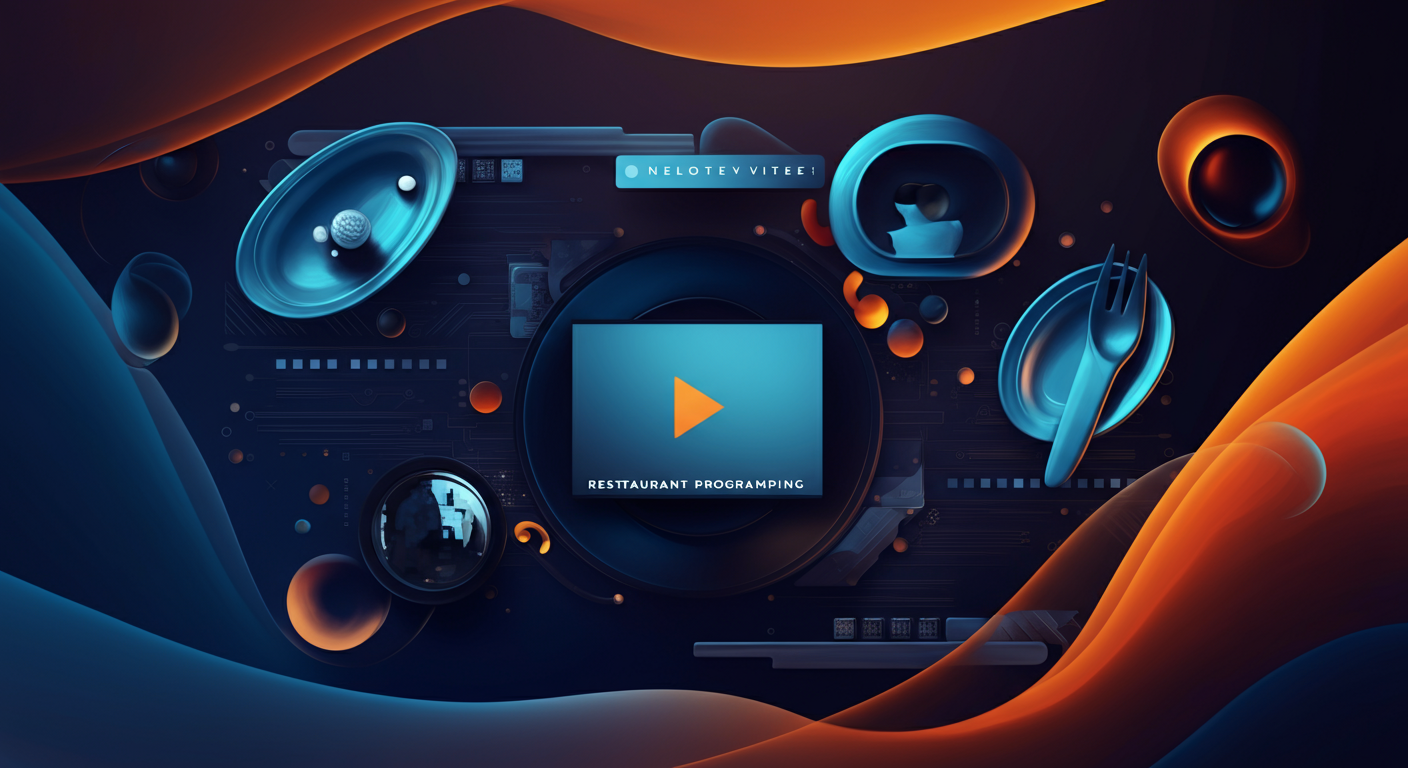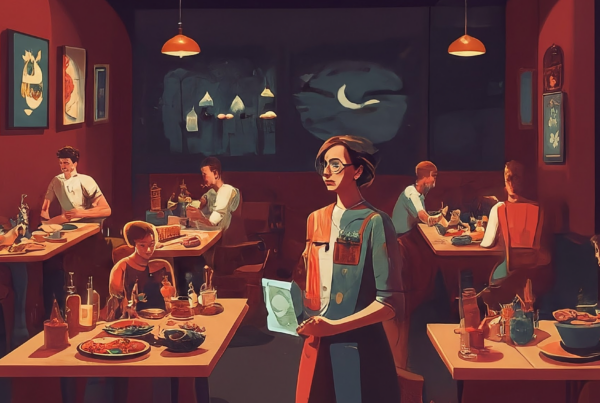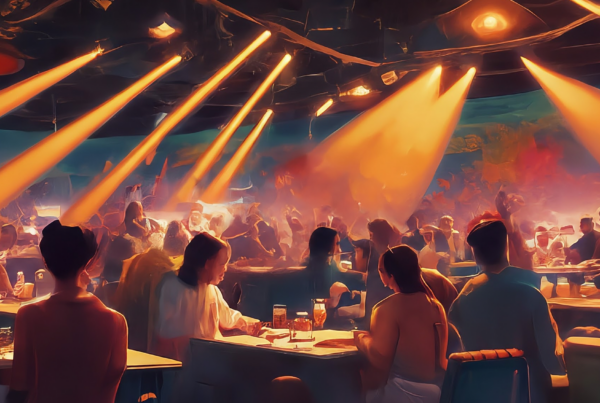In the bustling world of hospitality, standing out is no small feat. As we step into 2025, the landscape of customer engagement is rapidly evolving, with Innovative Strategies for Restaurant Video Programming taking center stage. Imagine walking into a restaurant where dynamic video content not only enhances the ambiance but also aligns with your tastes and preferences. This isn’t just a futuristic dream—it’s the new reality for forward-thinking businesses determined to captivate their audience.
For those in the hospitality and entertainment industries, particularly restaurants, the integration of video programming isn’t just a luxury—it’s a necessity. As consumer expectations rise, so does the need for tailored experiences that go beyond the traditional dining setup. Here, video content plays a pivotal role in not only showcasing your brand’s unique offerings but also in creating an engaging atmosphere that resonates with your clientele. According to recent studies, video content is projected to account for over 82% of all consumer internet traffic by 2025, highlighting its undeniable impact on customer engagement.
At DLM Media, we understand the power of expertly curated video programming. Our mission is to provide businesses with seamless, reliable solutions that enhance customer experiences and drive engagement. By leveraging cutting-edge strategies, we empower multi-location organizations and hospitality venues to implement video content that speaks directly to their guests’ preferences. Whether it’s through showcasing culinary masterpieces or delivering immersive brand stories, our approach ensures that your restaurant stands out in a competitive market.
Ready to transform your restaurant’s customer experience with innovative video strategies? Dive into our comprehensive guide, where we’ll explore the latest trends, practical tips, and success stories that illustrate the transformative power of video programming in the hospitality industry. Discover how you can leverage these insights to elevate your brand and captivate your audience like never before.
Maximizing Customer Engagement with Video Content
Video content is revolutionizing the way restaurants engage with their customers. By leveraging high-quality visuals and authentic storytelling, restaurants can create immersive experiences that captivate their audience. This section explores how to maximize customer engagement through strategic video content, drawing insights from successful campaigns and industry best practices.
With the rise of digital media, video has become a dominant force in online engagement. According to recent statistics, video content accounts for over 80% of all internet traffic, underscoring its importance in capturing consumer attention. For restaurants, this means an opportunity to showcase their unique offerings, from tantalizing menu items to the vibrant atmosphere and dedicated staff.
Showcasing Your Menu and Atmosphere
One of the most effective ways to engage customers is by showcasing your menu through video. High-quality visuals of your dishes can entice potential customers and highlight the culinary expertise of your chefs. Consider using close-up shots and dynamic angles to capture the textures and colors of your food, making it irresistible to viewers.
Beyond the menu, videos can also convey the ambiance of your restaurant. Highlighting the decor, music, and overall vibe helps set expectations and attract the right clientele. For instance, a video tour of your dining area, accompanied by ambient sounds, can give viewers a taste of the dining experience you offer.
Authentic Storytelling and Customer Connection
Authenticity is key to successful video content. Customers are drawn to genuine stories that resonate with their experiences and values. By sharing the stories behind your dishes or the journey of your restaurant, you create a connection with your audience that goes beyond the transactional.
Consider featuring your staff in videos to humanize your brand. Interviews with chefs or behind-the-scenes footage of kitchen operations can offer insights into the passion and dedication that goes into every dish. This approach not only builds trust but also fosters a sense of community among your customers.
Leveraging Successful Video Campaigns
Learning from successful video campaigns can provide valuable insights into what works in the industry. For example, restaurants that have embraced user-generated content often see higher engagement rates. Encouraging customers to share their dining experiences through video can amplify your reach and build credibility.
Additionally, incorporating interactive elements, such as polls or Q&A sessions, into your video content can boost engagement. These strategies invite viewers to participate actively, making them feel more connected to your brand.
By implementing these strategies, restaurants can harness the power of video to enhance customer engagement and drive business growth. For more insights on innovative video strategies, explore our resources at DLM Media.
Implementing Video Programming in Your Restaurant
Incorporating video programming into your restaurant can significantly enhance customer engagement and brand visibility. However, this requires strategic planning and execution. Many successful restaurants start with affordable tools and gradually scale up their video initiatives. This approach not only minimizes initial costs but also allows for flexibility and adaptation as your video strategy evolves.
Aligning video content with your brand identity is crucial. Your videos should reflect the unique atmosphere and values of your restaurant, whether it’s a cozy family diner or a high-end gourmet establishment. By doing so, you ensure that your video content resonates with your target audience and reinforces your brand message.
Choosing the Right Tools and Technologies
To begin, explore the various tools and technologies available for video creation. Modern smartphones equipped with 4K video capabilities can serve as a cost-effective starting point. Additionally, consider using apps like Filmic Pro or MAVIS, which offer manual control over video settings for more professional results.
For editing, tools such as Adobe Premiere Rush and InShot provide user-friendly features for trimming, transitions, and color correction. These applications help ensure your videos are polished and ready for publication. Incorporating inexpensive peripherals like clip-on microphones and LED lighting can further enhance the quality of your video content.
Setting Up Video Programming: A Checklist
Implementing video programming in your restaurant involves several key steps. Here’s a checklist to guide you through the process:
- Define Your Objectives: Determine what you aim to achieve with video programming, such as increasing foot traffic or enhancing brand awareness.
- Select the Right Equipment: Choose cameras, microphones, and lighting that fit your budget and quality requirements.
- Create a Content Plan: Outline the types of videos you want to produce, such as menu showcases or behind-the-scenes tours.
- Align with Brand Identity: Ensure all video content reflects your restaurant’s unique style and values.
- Schedule Regular Updates: Plan a timeline for releasing new video content to keep your audience engaged.
- Monitor and Adjust: Use analytics to track video performance and make necessary adjustments to your strategy.
Aligning Video Content with Brand Identity
Your video content should be a seamless extension of your restaurant’s brand. This means incorporating elements that highlight your establishment’s unique offerings and atmosphere. For example, if your restaurant is known for its vibrant decor and lively ambiance, your videos should capture these elements to attract the right clientele.
Consider featuring your staff and their stories to humanize your brand. This approach not only builds trust but also fosters a sense of community among your customers. By sharing authentic stories and behind-the-scenes insights, you create a connection with your audience that goes beyond the transactional.
For more insights on implementing effective video strategies, visit DLM Media for resources and expert guidance tailored to the hospitality industry.
Measuring the Impact of Video Programming
Understanding the effectiveness of your video programming is essential for continuous improvement and success. By tracking specific metrics, you can gain valuable insights into how your video content is performing and make data-driven decisions to enhance your strategies. In this section, we’ll explore the key metrics to monitor and the tools you can use to measure the impact of your video programming.
As highlighted by competitors, focusing on metrics such as engagement rates and conversion rates can provide a clear picture of your content’s success. These metrics help identify what resonates with your audience and where adjustments are needed to optimize performance.
Key Metrics to Track
To effectively measure the impact of your video programming, consider tracking the following key metrics:
- Engagement Rate: This metric indicates how actively viewers are interacting with your video content. It includes likes, shares, comments, and average watch time. A higher engagement rate suggests that your content is resonating well with your audience.
- Conversion Rate: This measures the percentage of viewers who take a desired action after watching your video, such as making a reservation or signing up for a newsletter. Tracking conversion rates helps assess the effectiveness of your call-to-action.
- View Count: While not the only indicator of success, the number of views provides a baseline for understanding the reach of your video content.
- Completion Rate: This metric shows the percentage of viewers who watch your video from start to finish. A high completion rate indicates that your content is engaging and holds the audience’s attention.
Tools for Measurement
Several tools can help you track and analyze these metrics:
- Google Analytics: Use this tool to track traffic driven by your video content and understand user behavior on your website.
- Social Media Insights: Platforms like Facebook and Instagram offer built-in analytics to monitor engagement and reach.
- YouTube Analytics: Provides in-depth data on viewer demographics, watch time, and engagement for videos hosted on YouTube.
- Video Hosting Platforms: Services like Vimeo and Wistia offer analytics features tailored to video content, helping you track performance across different channels.
Interpreting Data and Making Informed Decisions
Once you’ve gathered data from these tools, the next step is to interpret the results and make informed decisions. Look for trends and patterns in your metrics to identify what types of content perform best. For example, if videos showcasing behind-the-scenes content have higher engagement rates, consider producing more of this type of content.
Use A/B testing to experiment with different video formats, lengths, and calls-to-action. This approach allows you to refine your strategy based on what drives the most engagement and conversions. Additionally, consider using charts or graphs to visualize key metrics and trends, making it easier to communicate your findings with your team.
By consistently measuring and analyzing the impact of your video programming, you can ensure your content remains relevant and effective in engaging your audience. For more insights on optimizing your video strategies, explore additional resources at DLM Media.
Elevate Your Restaurant with Strategic Video Programming
As we have explored throughout this guide, leveraging innovative strategies for restaurant video programming can significantly transform your dining establishment. By integrating dynamic video content tailored to your audience’s preferences, you can enhance customer engagement and create memorable experiences that set your restaurant apart in a competitive industry.
Implementing video programming doesn’t require a massive investment or a complete overhaul of your current operations. Start small by utilizing affordable tools and gradually expand your efforts as you see results. Consider beginning with smartphone videos, which can be surprisingly effective with the right lighting and composition. As your confidence grows, explore more sophisticated equipment and editing software to elevate your content further.
To ensure your video content is impactful, align it with your brand identity. Whether your restaurant exudes a cozy, intimate vibe or a lively, energetic atmosphere, your videos should reflect these qualities. Highlighting your staff, unique dishes, and customer stories can create an authentic connection with your audience. This approach not only humanizes your brand but also fosters a sense of community among your customers.
- Key Takeaways:
- Start small with affordable tools and scale up as needed.
- Align video content with your restaurant’s unique brand identity.
- Use videos to showcase your menu, staff, and customer stories.
- Regularly measure the impact of your video content to refine strategies.
We invite you to explore more resources and success stories at DLM Media to gain further insights into implementing effective video strategies. By continuously engaging with expert content and adapting to industry trends, you can ensure your restaurant remains at the forefront of customer engagement and satisfaction.





